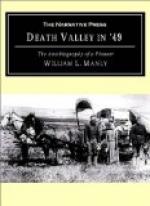The range was before us, and we must get to the other side in some way. We could see the range for a hundred miles to the north and along the base some lakes of water that must be salt. To the south it got some lower, but very barren and ending in black, dry buttes. The horses must have food and water by night or we must leave them to die, and all things considered it seemed to be the quickest way to camp to try and get up a rough looking canon which was nearly opposite us on the other side. So we loaded the mule and made our way down the rocky road to the ridge, and then left the Jayhawker’s trail, taking our course more south so as to get around a salt lake which lay directly before us. On our way we had to go close to a steep bluff, and cross a piece of ground that looked like a well dried mortar bed, hard and smooth as ice, and thus got around the head of a small stream of clear water, salt as brine. We now went directly to the mouth of the canon we had decided to take, and traveled up its gravelly bed. The horses now had to be urged along constantly to keep them moving and they held their heads low down as they crept along seemingly so discouraged that they would much rather lie down and rest forever than take another step. We knew they would do this soon in spite of all our urging, if we could not get water for them. The canon was rough enough where we entered it, and a heavy up grade too, and this grew more and more difficult as we advanced, and the rough yellowish, rocky walls closed in nearer and nearer together as we ascended.
A perpendicular wall, or rather rise, in the rocks was approached, and there was a great difficulty to persuade the horses to take exertion to get up and over the small obstruction, but the little mule skipped over as nimbly as a well-fed goat, and rather seemed to enjoy a little variety in the proceedings. After some coaxing and urging the horses took courage to try the extra step and succeeded all right, when we all moved on again, over a path that grew more and more narrow, more and more rocky under foot at every moment. We wound around among and between the great rocks, and had not advanced very far before another obstruction, that would have been a fall of about three feet had water been flowing in the canon, opposed our way. A small pile of lone rocks enabled the mule to go over all right, and she went on looking for every spear of grass, and smelling eagerly for water, but all our efforts were not enough to get the horses along another foot. It was getting nearly night and every minute without water seemed an age. We had to leave the horses and go on. We had deemed them indispensable to us, or rather to the extrication of the women and children, and yet the hope came to us that the oxen might help some of them out as a last resort. We were sure the wagons must be abandoned, and such a thing as women riding on the backs of oxen we had never seen, still it occurred to us as not impossible and although leaving




